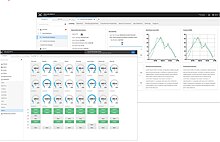Draft:Microscada
| Submission declined on 18 December 2023 by Lewcm (talk). This draft's references do not show that the subject qualifies for a Wikipedia article. In summary, the draft needs multiple published sources that are:
Where to get help
How to improve a draft
You can also browse Wikipedia:Featured articles and Wikipedia:Good articles to find examples of Wikipedia's best writing on topics similar to your proposed article. Improving your odds of a speedy review To improve your odds of a faster review, tag your draft with relevant WikiProject tags using the button below. This will let reviewers know a new draft has been submitted in their area of interest. For instance, if you wrote about a female astronomer, you would want to add the Biography, Astronomy, and Women scientists tags. Editor resources
|  |
| Submission declined on 7 November 2023 by Voorts (talk). This draft's references do not show that the subject qualifies for a Wikipedia article. In summary, the draft needs multiple published sources that are:
|  |
| Submission declined on 5 November 2023 by WikiOriginal-9 (talk). This draft's references do not show that the subject qualifies for a Wikipedia article. In summary, the draft needs multiple published sources that are:
|  |
| Submission declined on 1 April 2023 by CNMall41 (talk). This draft's references do not show that the subject qualifies for a Wikipedia article. In summary, the draft needs multiple published sources that are:
|  |
| Submission declined on 24 March 2023 by Eejit43 (talk). This submission is not adequately supported by reliable sources. Reliable sources are required so that information can be verified. If you need help with referencing, please see Referencing for beginners and Citing sources. This draft's references do not show that the subject qualifies for a Wikipedia article. In summary, the draft needs multiple published sources that are:
|  |
 Comment: Not enough independent, significant coverage. WikiOriginal-9 (talk) 20:05, 5 November 2023 (UTC)
Comment: Not enough independent, significant coverage. WikiOriginal-9 (talk) 20:05, 5 November 2023 (UTC)
 | |
| File:MicroSCADA Pipeline and Workplace X.jpg MicroSCADA X | |
| Original author(s) | Strömberg Oy |
|---|---|
| Developer(s) | Hitachi Energy |
| Initial release | 1983 |
| Stable release | SYS600 10.5, DMS600 4.7
/ March 15, 2023 |
| Platform | x86-64 |
| Available in | Multilingual |
| License | commercial software |
| Website | www |
MicroSCADA is a type of Supervisory Control and Data Acquisition (SCADA) software used in industrial automation and control applications such as power generation, distribution, and transmission systems, water treatment plants, and manufacturing facilities. It is used for monitoring and control of processes and equipment like circuit breakers and switches as well as in large rectifiers, and static frequency converters.

History[edit]
MicroSCADA initially started in 1981 in the Finnish electrotechnical company Strömberg Oy, which was founded by Gottfrid Strömberg in 1889. Originally named Strömberg Control System (SCS), it was active mainly in Finland and in the Nordic countries but to some degree also in other countries.[1]
Application[edit]
MicroSCADA is used for automation and control for transportation, [industry]], infrastructure, electricity and renewable utilities.[2].
MicroSCADA is used in substations and control centers. It consist of a central control unit that collects data from remote IEDs and other substation devices, and provides a graphical user interface for operators to monitor and control the system. The system may be configured to generate alarms in events such as faults. When fault situations happen in the power network, the control system receives an alarm. After the issue is resolved, the alarm can be set as acknowledged by the operator.

MicroSCADA uses a Hot-Standby concept in which a one device takes in control and when problem occur the redundant extra system takes over. It can be integrated to a higher level sub-master SCADA or even grand master SCADA to collect data from digital overcurrent relays (DRLs), distribution line communication (DLC) modules, automatic meter reading (AMR) etc and send it to the sub-master station for supervisory monitoring.[3]
Subsystems[edit]
MicroSCADA has three subsystems namely SYS600 and DMS600 as well as the hardware SYS600C.
- SYS600 software is used in control and monitoring of substations as an automation system for remote and local control of substations, disconnector stations, diesel and hydro-electric power plants and remote control of district heating.

Customized Views in MicroSCADA
- DMS600 in the other hand is a distribution management system. It is used for managing and remote controlling of power distribution networks. It is also used in fault analysis and maintenance outage management in power distributions.
- SYS600C is an industrial computer in which MicroSCADA can be installed for used in electrical substations. It is manufactured together with SYS600 software.
References[edit]
- ^ Shannon, Cuthrell (2023). "Charting the 40-Year History of MicroSCADA Power Automation". Retrieved 6 November 2023.
- ^ https://osuva.uwasa.fi/handle/10024/9012, Mämmi, Joona. 2019, Cybersecurity of MicroSCADA Pro for Power Stations.
- ^ M. Ghaly, M. M. Ali, M. R. Ghononemy, A. El-Bialy, A. Hisham Kandil and H. A. Darwish, "A novel microscada system for Middle Egypt Electricity Company," 16th International Conference and Exhibition on Electricity Distribution, 2001. IEEE
External links[edit]
- Article on a solution for stability using MicroSCADA A solution for stability

